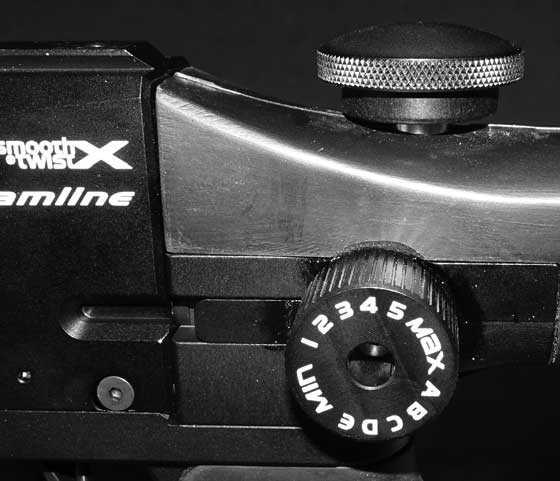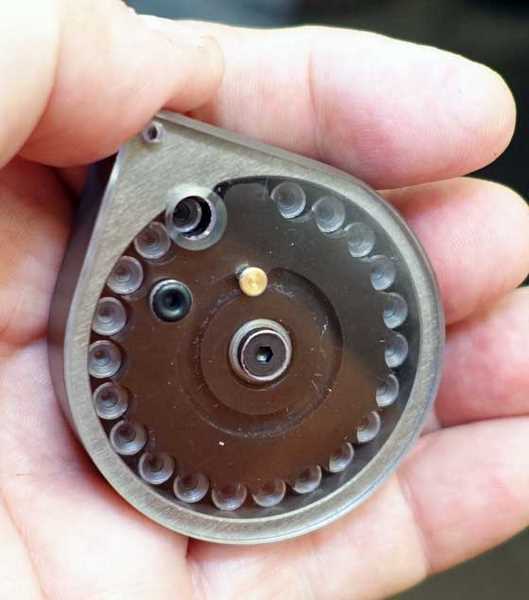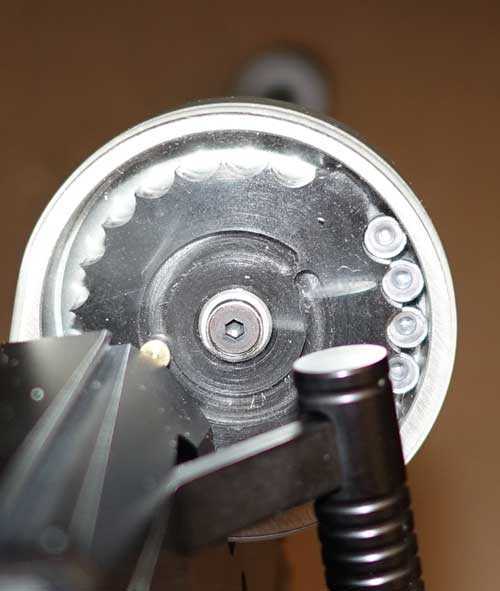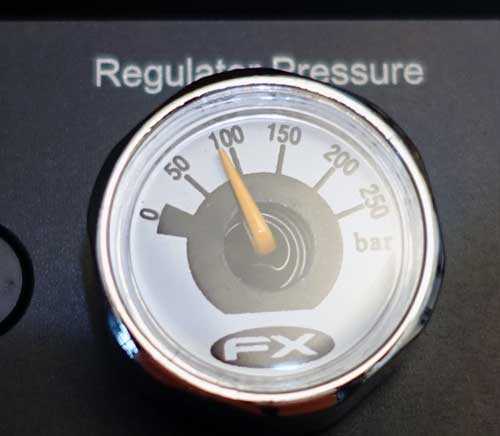by Tom Gaylord
Writing as B.B. Pelletier
This report covers:
- Correction
- Start velocity test
- Transfer port
- Hammer spring tension
- My test
- Big test
- Where is the knob pointing?
- Played with the rifle to learn how it works
- Max power (up) 90 bar reg 155 bar in reservoir
- Reservoir reads 155 bar, Max power (up) 90 bar reg
- Filled reservoir to 230 bar, max power (up), 90 bar reg
- Power knob to 4 (up), reg at 90 bar reservoir reads 220 bar (last fill may have been light)
- Power knob to 2 (up), reg at 90 bar reservoir reads 210 bar
- Power knob to Min (up), reg at 90 bar reservoir reads 200 bar
- Power knob to B (up), reg at 90 bar reservoir reads 195 bar
- Power knob to D (up), reg at 90 bar reservoir reads 190 bar
- Power knob to Max (up), reg at 90 bar reservoir reads 180 bar
- Discharge sound
- Cocking
- Trigger-pull
- Summary
Correction
I begin today’s report with a large correction of Part 1. I said the Smooth Twist X barrel is not rifled until the end of the barrel. That is true of the original Smooth Twist barrel, but not the Smooth Twist X. The Smooth Twist X is rifled all the way up the bore. I have read many reports of stunning accuracy from this rifle — actually from the entire Dreamline series — and I hope the test rifle will be one of those.
Start velocity test
Today I will look at the velocity of the test rifle. Now we know that there are three adjustments on this rifle. The regulator is adjustable, the air transfer port is adjustable and the hammer spring tension is adjustable. While the manual sadly lacks pertinent information on how to adjust any of these things, reader Yogi posted a link to the FX drawing of the Dreamlite that shows the hammer spring adjuster is a rack and pinion gear.
After playing with the knob for a while I discovered that the adjustments increase and decrease as the knob it turned in either direction. I will have to experiment to affirm that, plus to see if the rifle comes back when it is set to the same place.
I won’t be able to test every possible adjustment for you. There are too many. What I will do is establish a baseline and see what the adjustments do from there. If I owned this rifle that is exactly how I would test it for myself.
The baseline
Now let’s look at where the rifle will be set at the start of the test. The rifle came to me with the regulator set at 100 bar. I will leave it there to start the baseline of this test. If I change it I will tell you.
Transfer port
The air transfer port has 4 positions. It’s got to be set on one of those 4 so the hole through the port will align with the valve. You can’t set it in-between them or no air will flow. For today’s tests I will leave the air transfer port set on the .177/.22 setting that I showed in Part 1.
Hammer spring tension
Who knows where the hammer spring is at this time? There is no index mark to align anything with and the knob is engraved with numbers, letters and the words Max and Min.

The hammer spring adjustment is confusing, but testing should straighten it out.
My test
I don’t care about maximum power. I will test the rifle with good heavy pellets, but not with solid slugs! The Dreamlite’s circular magazine prevents me from using the longest heaviest pellets anyway. The manual cautions you not to exceed 16 grains in .177 caliber for a different FX air rifle, but I think it also applies to this one.
Besides velocity I am interested in stability. Does the velocity return to the same place every time when the controls are set the same?
My review seems to be the only one that’s focused on the .177-caliber Dreamlite. Everybody seems to be going for the most power. Normally I would be right there with them, but with the AirForce Condor and the new Ring Loc Kit on the market, I think that’s a futile quest. Instead I will concentrate on what this rifle has to offer — adjustability, accuracy and a fine trigger.
I also want to know how low the Dreamlite can go. Can it drop below 12 foot-pounds to be legal in international field target matches? I don’t know — gonna try to find out. At 20 foot-pounds it’s certainly okay for American matches as is.

The .177 Dreamlite mag holds 21 pellets!

The high mag makes the pellets easy to watch.
Big test
That’s a lot to test. I won’t finish everything today, but because many readers are waiting to see the accuracy, I will split this test up into parts that I publish now and later. Because of the lack of documentation and the lack of information about the .177 caliber Dreamlite — as far as I have been able to discover — this was the largest and most confusing velocity test I ever conducted.
Where is the knob pointing?
Look up at that power knob again. Where it is pointing? There is no way to tell. When I started the test I thought it should “point” forward toward the front of the rifle, but I soon discovered there are more stops in the knob than there are markings. So, I played around with it awhile and settled on straight up as my reference point. It may be hard for you to understand how confusing this is, but it’s really difficult. I will get a handle on it, but apparently I have farther to go.
One thing I did establish is the knob returns to roughly the same place every time it’s rotated. Clockwise or counter-clockwise doesn’t seem to matter. When “Max” is at the top, the velocity is roughly the same regardless of how many turns the knob has gone through or the direction they took. That means that each power setting should repeat.
Played with the rifle to learn how it works
I shot the rifle 62 times with Baracuda Match pellets, trying to figure out that power knob. As the test progressed I also lowered the reg pressure from 100 bar to 90 bar for the final 13 shots. The rifle shot faster on the Max power setting at 90 bar than it had at 100 bar.

This is where I set the regulator. I don’t care if it’s 90 bar or 93 bar — I’m using this picture for my own future reference.
Over the 62 shots the reservoir pressure had dropped from 230 bar to 155 bar. With the reg set at 90 bar, there are still many shots until the rifle drops below 90 bar in the reservoir and falls off the regulator.
Max power (up) 90 bar reg 155 bar in reservoir
Shot…..Vel.
1……..850
2……..848
3……..846
4……..832
5……..838
6……..847
7……..838
8……..850
At 840 f.p.s. this 10.65-grain pellet generates 16.69 foot-pounds at the muzzle.
I’m not looking for averages yet, but this is how the test rifle performs for 8 shots on those settings. HOWEVER — I think the reg on this test rifle is a little slow. So, on the next test I will wait 5 seconds between each shot.
I turned the power knob three complete turns counter-clockwise and stopped with the Max reading up again.
Reservoir reads 155 bar, Max power (up) 90 bar reg
Shot….Vel.
1……..847
2……..840
3……..840
4……..835
5……..836
Okay, what I can say at this point is the reg does take time to fill with air. Fortunately we just learned about that in another test a few days ago, so no surprise there. The rifle now has 150 bar in the reservoir and the reg is set at 90 bar. The power should be identical at this pressure to what it is if the reservoir is filled to 230 bar, so I filled it to see.
Filled reservoir to 230 bar, max power (up), 90 bar reg
Shot….Vel.
1……..836
2……..835
3……..837
4……..843
5……..840
That’s very close between 150 bar and 230 bar. I will call the rifle stable at this time. Now I will adjust the power knob to several different settings. I played with these during the first 60 shots, so I have some idea of what to expect.
Power knob to 4 (up), reg at 90 bar reservoir reads 220 bar (last fill may have been light)
Shot….Vel.
1……..757
2……..753
3……..751
4……..757
5……..750
At 753 f.p.s. this 10.65-grain pellet develops 13.41 foot-pounds at the muzzle.
I am now waiting perhaps 8-10 seconds between the shots, letting that reg fill again. And the rifle is becoming more uniform.
Power knob to 2 (up), reg at 90 bar reservoir reads 210 bar
Shot….Vel.
1……..710
2……..706
3……..706
4……..714
5……..708
At 710 f.p.s. this 10.65-grain pellet develops 11.92 foot-pounds at the muzzle. There is my sub-12 foot pounds and I shot it with a heavy pellet. Obviously the Dreamlite can go lower!
Power knob to Min (up), reg at 90 bar reservoir reads 200 bar
Shot….Vel.
1……..712
2……..710
3……..719
4……..708
5……..710
Velocity gained just a little. I don’t know if putting the power setting at the top is correct yet, so although I am thinking it’s set to Min, it might be somewhere else. What about the letters on the power knob?
Power knob to B (up), reg at 90 bar reservoir reads 195 bar
Shot….Vel.
1……..759
2……..756
3……..758
4……..754
5……..747
Power knob to D (up), reg at 90 bar reservoir reads 190 bar
Shot….Vel.
1……..711
2……..713
3……..716
4……..712
5……..712
Well, I don’t know what to say about the letters. They don’t seem to act like the numbers do. But let’s set the power to Max (up) again and see where it takes us.
Power knob to Max (up), reg at 90 bar reservoir reads 180 bar
Shot….Vel.
1……..845
2……..835
3……..837
4……..835
5……..830
The velocity went back to about the same place when the knob was set back to Max (up). The Dreamlite is repeatable, but for a regulated air rifle it’s not yet as stable as I’d like to see it. However, for a hunting gun it’s probably all that’s required. I do think that the reg will work faster as the rifle breaks in, just as we discussed last week.
Discharge sound
The Dreamlite is whisper quiet! It’s been a few years since I heard a PCP that was this quiet, and the silencer that did that was over a foot long. This one is compact! It is way quieter than my .22 rimfire silencer with subsonic ammo!
Cocking
The rifle cocks and feeds each pellet butter-smooth. I have to say it’s the best repeater (for a smooth repeating function) I have ever tested and almost as nice as a 10 meter target rifle for smooth feeding. The magazine functioned quite well. I loaded it five times for today’s testing!
Trigger-pull
The two stage trigger has a light first stage (12 ounces) that stops positively at stage two. Stage two breaks crisply at 17 ounces. It’s very similar to the feel of a 10-meter target rifle trigger, though heavier. Many shooters are going to have to get used to it, because it is so light!
Summary
I’m just getting started! I only tested with a single pellet today and I only really tested the power knob at a reg setting of 90 bar. There is still the variable transfer port adjustment to test, though I will leave it where it is for the first accuracy test.
If this Dreamlite turns out to be as accurate as I have read, I will probably buy it. It’s such a flexible powerplant that I need it — plus it’s quiet enough to eliminate pests in my small suburban backyard.
The adjustable regulator works well, but doesn’t control the velocity as closely as other regulators do. That may not be a problem — OR the rifle may just need an extended break-in period for things to slick up.
What a shame FX doesn’t tell you more about the rifle in the manual. This manual is like the ones the Brits used to ship with their PCPs back in the early ’90s. This one has more words and better pictures, but it’s a total confusion when you try to use it.
Behind the poor documentation lies a very nice precharged pneumatic air rifle — I think. If it will shoot as well for me as it has for others, I will call it a winner.


It is a shame that FX will ship a rifle like that with such a minimal manual.
Its like handing someone keys to a vehicle with a 10 speed transmission, and a 3 speed rear end and say go have fun…
One of the Dreamlines is on my short list for this year.
I appreciate the time and effort it takes to test, and compile, and write all the settings, but for $1200 you should not have to do that.
But with all of the adjustments you listed, and not having a rifle in hand to compare what knob did what at what setting, after the 3rd or 4th string, it all started to sound like the teacher in the old Charlie Brown Christmas specials.
That or maybe I am just tired, and its late..
Hopefully the accuracy section will be easier on the brain…
B.B.
Love the reporting on this gun!
At some point could you do a blog on pellets vs slugs? I only do .177 and .22 so not sure it will apply to me.
Just want to know, WHY?
-Y
Yogi,
Much better BC (ballistic coefficient) for one. Getting the pellet/bullet from point A to point B with the minimal amount of FPE loss,… which also correlates with FPS loss.
From what I am gathering from my minimal exposure to the topic,…. different twist and faster fps are required in general. PCP basically.
Like you, I would be curious to get B.B.’s take on the pellet VS the bullet type air gun ammo and what is best suited to bullet type ammo.
Good Day,……… Chris
OK,
but which has the higher BC?
-Y
Yogi,
A bullet has a ballistic coefficient that is an order of magnitude greater (higher) than a diabolo pellet.
B.B.
Thank you!
So the “spin rate” does not need to be as high?
Also, won’t “lead free”(lighter) alloys be better suited to slugs?
-Y
Yogi,
It has to be higher/faster. Bullets are only stabilized by their spin. Pellets are stabilized first by their high drag and only a little by their spin.
B.B.
B.B. & Yogi,
This is why a barrel that shoots pellets well will most likely not do well with bullets. From what I have read, matching a barrel twist rate to a bullet’s weight and shape is a science unto itself.
Gerald
Exactly!
Wonder if computer modeling can optimize this?
Maybe, pellet manufactures can print of the tin the best spin rate.
-Y
Yogi,
The computer may be able to figure it out but the numbers change in the real world. As an example, two air guns with the same barrel twist but shoot the same slug at different velocities will impart a different spin rate. Both factors have to work together to make the projectile stable in flight.
Gerald
Participant,
I seem to remember that spin rate would be the same,.. if the twist rate was the same,…. even though the 2 guns may have different fps.
I am pretty sure I read it here,…. but I could be completely off base as well.
Chris
I was wrong it would appear,……
Spin is induced by rifling, which are lands or ridges cut in a spiral inside the bore. These ridges or lands cut into the sides of the bullet (it’s called engraving) and make it turn to follow them. As the bullet travels down the barrel it rotates according to the rate at which the lands turn. And here is the first truth you need to grasp. Whether the barrel is 2 inches long or twenty inches long, if the twist rate is the same and the velocity remains identical, the bullet will always spin at the same rate. That’s right — a 2-inch barrel with a 1:10” twist spins a bullet just as fast as a 20-inch barrel with the same twist — as long as the bullet is driven through both barrels at the same velocity. Longer barrels don’t spin the bullet more.
And, here is the second truth you need to learn — regardless of the twist rate, the faster the bullet travels through a barrel, the faster it spins. It is the bullet’s velocity that determines how fast it spins, not the barrel’s twist rate. That said, a faster twist barrel will spin a bullet faster at a given velocity.
So, if the barrel has a twist rate of one turn for every 12 inches of travel (written as 1:12”) and the bullet is shot at 1,000 f.p.s. it exits the muzzle spinning 1,000 times per second. If it is shot through the same bore at 2000 f.p.s. it exits the muzzle spinning 2,000 times per second. The length of the barrel has no bearing on this.
Chris (per a prior B.B. article)
/blog/2017/02/they-have-the-wrong-twist-rate-part-1/
B.B.,
While hesitant to say it,….. this may be one of those times that you might want to veer off your longstanding testing protocol (of not doing research, not watching video reviews, not reading revues, etc., etc.) and seek out anything you can find on the adjustments.
It may answer a few questions, explain a few things and allow you to formulate a more confident test plan.
On the striker adjustment,…. I think of the Marauder in which you can back/bottom it out and count the turns. That at least gives you a reference point to count from.
Looking forwards to more testing.
Good Day to you and to all,……… Chris
Chris,
Thanks, but I already have started reading about this rifle. That’s why I say what I did about the lack of info on the .177.
B.B.
B.B.,
As many have said before, “This is a tinkerer’s gun!” I foresee a recurring series for this especially if it proves as accurate as advertised. Caliber .177 for now then slugs in (?) caliber next?
Siraniko
Are slugs better just in the larger calibers?
If so why?
-Y
Yogi,
I don’t know but it seems to make sense when you want to deliver more energy to your target. Using a small caliber slug seems pointless if it will just pass through. Just pointing out a possible avenue for research.
Siraniko
Yogi,
“Sugs” or cast bullets work very well in the smaller calibers also IF the twist rate is correct. This is why FX will be offering various twist rates in their Smooth Twist X barrels.
BB,
Just go ahead and buy it. Lord knows you don’t need it, but go ahead and buy it anyway. You will not regret it.
😉
Indeed a very interesting rifle this FX Dreamline/lite/more or less anything you want it to be.
Check this short video of the many possibilities of configuration;
https://www.youtube.com/watch?v=iUxh-fRuyPw
Mike
Anyone besides me think that this thing looks like the bad end of a flame thrower ???
tt
That will be their next “extra barrel” sleeve. Just put pressured accelerant in the air bottle?
-Y
Twotalon,
So it does! Maybe for closer in work somebody will remake ether capsules to roast the critters. 🙂
Siraniko
Chris,
You nailed it! 🙂
B.B.
B.B.,
You nailed it way before me,…… that is copy and paste you word for word. 😉 Now,.. if I can only figure out a way whereas I don’t have to keep (re)nailing things!
Chris
I saw a few comments regarding the use of slugs so I thought this video might be of interest. It seems the main purpose of using slugs is to achieve greater range (higher BC), and they are less affected by wind.
In this video, he successfully tested shooting AVS Slugs out of the ATI Nova Liberty .22 at 100 Yards under an Inch. 10 shot groups were just over an inch but very tight. He will be offering these slugs on Ebay under the name AVS slugs (Air Velocity Sport). https://www.youtube.com/watch?v=CrVSzqlqbk4&feature=em-uploademail
I just ordered one of the Liberty’s during a Father’s Day Sale… about $185 shipped.
I can’t believe how inexpensive decent shooting PCP’s are these days.
I definitely won’t feel guilty dropping it out in the field.
(I generally have a heart attack every time I lose my balance with my Crown.)
I kept chanting… go watch Ernest, go watch Ernest… and want to see the rifle tested again after BB is an expert at the FX… or maybe it will happen by Part III…
BB
Anyone considering owning this airgun really needs to visit the FX web site first and explore the options available. There must be a good reason why the 22cal is discussed the most. My FX Independence is 22cal and I personally believe a .177 PCP does not take full advantage of a PCP’s ability. Unless of course you have a very specific intended use that requires a .177 pellet. I even stepped up to a .25cal with my FX Indy.
I got both for the obvious benefits of having control over every shot and not needing a compressor, like the Seneca Aspen. It will be interesting to see if this rifle shoots better or just offers more ‘Options’.
Not that that’s a bad thing, having options is always good, but I believe most shooters will find their best ‘sweet spot’ and leave it there. The pre-sets on my Independence are totally acceptable.
Moving on, this rifle is a whole new step up in options …. Everything is adjustable, even the caliber !
Bob M
I’ve heard the South Africa boys have regulations that keep them shooting .22.
That’s why the .22 slug liner was released first.
Richard
That’s a good reason for getting a .177, no choice.
BB
I know your not going to dig into testing at max power settings but I would like to see at least one heavy .177 pellet fired at the max setting of all three adjustments to see how it performs. Yes, even at the 25/30 because it’s there.
The new hammerless rifles seem to be avoiding any comment on the maximum power available.
Bob M
Bob,
That seems like a worthy test.
B.B.